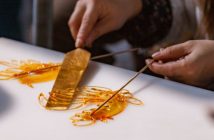For our column, Ask an Educator, we turn to educators, whether teachers, tutors, or principals, to answer frequently asked questions from parents. To send in your question, email jessicasuotmaa@beijing-kids.com.
This week, our question is:
“How can a preschool-aged child benefit from guided art classes?”
Answering for us is Lia Tedjokusumo, Art Director at Papp’s Tea and Art Educator at Blue Bridge International Education.

I have taught art classes to children as young as 18 months and as old as 15 years since 2014 when I first joined the Blue Bridge Art Educator team. However, there’s something special about my junior 1 and 2 classes that fueled my dedication to the specific levels of younger students.
The benefits for a preschool aged child taking guided art lessons are abundant. As art educators, we’re not only focusing on the process of creating an artwork and the end result of having a finished product, but we also design the class to have a simple, fun, yet firm structure that will allow our students to develop independence, self-esteem, and social skills. We aim to stimulate creativity at a baby-speed, where things are not rushed but can be naturally learned and practiced.
Why is baby-speed important? Children can practice fine motor skills and positive coping mechanisms through art lessons. I believe in learning prudently, which is what I saw in the children as they evolved class by class. It takes time, repetition, and a stable environment for children to build self-esteem, discipline, and independence.

Art classes allow young children to accomplish without unnecessary pressure. A lot of my students will seek approval for their work, and I always express to them that there’s no good or bad artwork; there’s only “your own” artwork, with less or more practice. What you do will never be the same as what others do, even if you try to copy each other’s work or technique–that’s the beauty of art lessons!
During art classes, students can also learn English while doing something they enjoy. Learning English in an art class is very different than learning English in a regular language class. The material might be less, the vocabulary taught might be simpler, but this makes it easier for young children to remember them. Even now, whenever any of my students tells me something they remember from a previous class, I get emotional (on the inside).
Photos: courtesy of Lia Tedjokusumo




